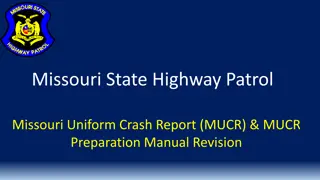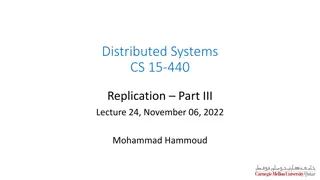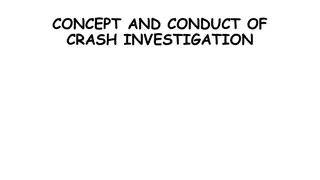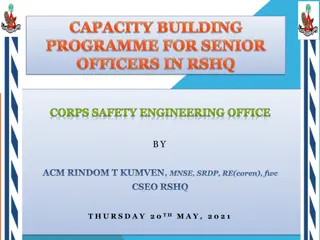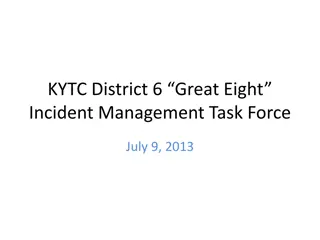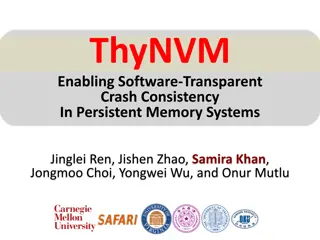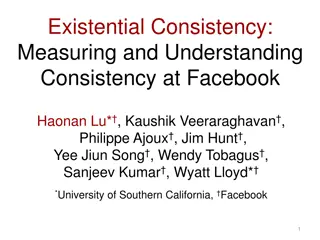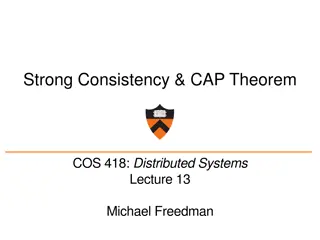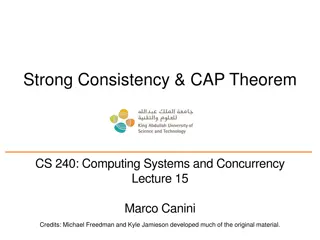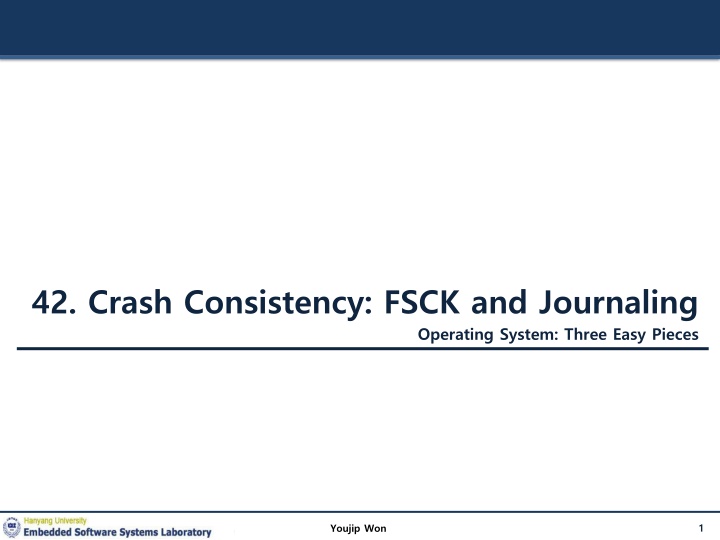
Crash Consistency in File Systems
Explore the challenges and solutions in maintaining data integrity during power loss or system crashes in file systems. Learn about fsck, journaling, and the importance of persisting data structures.
Download Presentation

Please find below an Image/Link to download the presentation.
The content on the website is provided AS IS for your information and personal use only. It may not be sold, licensed, or shared on other websites without obtaining consent from the author. If you encounter any issues during the download, it is possible that the publisher has removed the file from their server.
You are allowed to download the files provided on this website for personal or commercial use, subject to the condition that they are used lawfully. All files are the property of their respective owners.
The content on the website is provided AS IS for your information and personal use only. It may not be sold, licensed, or shared on other websites without obtaining consent from the author.
E N D
Presentation Transcript
42. Crash Consistency: FSCK and Journaling Operating System: Three Easy Pieces 1 Youjip Won
Crash Consistency 2 Youjip Won
Crash Consistency Unlike most data structure, file system data structures must persist They must survive over the long haul, stored on devices that retain data despite power loss. One major challenge faced by a file system is how to update persistent data structure despite the presence of a power loss or system crash. We ll begin by examining the approach taken by older file systems. fsck(file system checker) journaling(write-ahead logging) 3 Youjip Won
A Detailed Example (1) Workload Append of a single data block(4KB) to an existing file open() lseek() write() close() Inode Bitmap 8bit, 1/inode Data Bitmap Inodes Data Blocks 8 total 8 total, spread across 4 block 8bit, 1/data block I[v1] Da Before append a single data block single inode is allocated (inode number 2) single allocated data block (data block 4) The inode is denoted I[v1] 4 Youjip Won
A Detailed Example (2) Inside of I[v1] (inode, before update) owner : remzi permissions : read-only size : 1 pointer : 4 pointer : null pointer : null pointer : null Inode Bitmap 8bit, 1/inode Data Bitmap Inodes Data Blocks 8 total 8 total, spread across 4 block 8bit, 1/data block I[v1] Da Size of the file is 1 (one block allocated) First direct pointer points to block4 (Da) All 3 other direct pointers are set to null(unused) 5 Youjip Won
A Detailed Example (3) After update owner permissions size pointer pointer pointer pointer : remzi : read-only : 2 : 4 : 5 : null : null Inode Bitmap 8bit, 1/inode Data Bitmap Inodes Data Blocks 8 total 8 total, spread across 4 block 8bit, 1/data block I[v2] Da Db Data bitmap is updated Inode is updated (I[v2]) New data block is allocated (Db) 6 Youjip Won
A Detailed Example (end) To achieve the transition, the system perform three separate writes to the disk. One each of inode I[v2] Data bitmap B[v2] Data block (Db) These writes usually don t happen immediately dirty inode, bitmap, and new data will sit in main memory page cache or buffer cache If a crash happens after one or two of these write have taken place, but not all three, the file system could be left in a funny state 7 Youjip Won
Crash Scenario (1) Imagine only a single write succeeds; there are thus three possible outcomes 1. Just the data block(Db) is written to disk The data is on disk, but there is no inode Thus, it is as if the write never occurred This case is not a problem at all 2. Just the updated inode(I[v2]) is written to disk The inode points to the disk address (5, Db) But, the Db has not yet been written there We will read garbage data(old contents of address 5) from the disk Problem : file-system inconsistency 8 Youjip Won
Crash Scenario (2) Imagine only a single write succeeds; there are thus three possible outcomes (Cont.) 3. Just the updated bitmap (B[v2]) is written to disk The bitmap indicates that block 5 is allocated But there is no inode that points to it Thus, the file system is inconsistent again Problem : space leak, as block 5 would never be used by the file system 9 Youjip Won
Crash Scenario (3) There are also three more crash scenarios. In these cases, two writes succeed and the last one fails 1. The inode(I[v2]) and bitmap(B[v2]) are written to disk, but not data(Db) The file system metadata is completely consistent Problem : Block 5 has garbage in it 2. The inode(I[v2]) and the data block(Db) are written, but not the bitmap(B[v2]) We have the inode pointing to the correct data on disk Problem : inconsistency between the inode and the old version of the bitmap(B1) 10 Youjip Won
Crash Scenario (end) There are also three more crash scenarios. In these cases, two writes succeed and the last one fails (Cont.) 3. The bitmap(B[v2]) and data block(Db) are written, but not the inode(I[v2]) Problem : inconsistency between the inode and the data bitmap We have no idea which file it belongs to 11 Youjip Won
The Crash Consistency Problem What we d like to do ideally is move the file system from on consistent state to another atomically Unfortunately, we can t do this easily The disk only commits one write at a time Crashes or power loss may occur between these updates We call this general problem the crash-consistency problem 12 Youjip Won
Solution #1: The File System Checker 13 Youjip Won
The File System Checker (1) The File System Checker (fsck) fsck is a Unix tool for finding inconsistencies and repairing them. fsck check super block, Free block, Inode state, Inode links, etc. Such an approach can t fix all problems example : The file system looks consistent but the inode points to garbage data. The only real goal is to make sure the file system metadata is internally consistent. 14 Youjip Won
The File System Checker (2) Basic summary of what fsck does: Superblock fsck first checks if the superblock looks reasonable Sanity checks : file system size > number of blocks allocated Goal : to find suspect superblock In this case, the system may decide to use an alternate copy of the superblock Free blocks fsck scans the inodes, indirect blocks, dobule indirect blocks, The only real goal is to make sure the file system metadata is internally consistent. 15 Youjip Won
The File System Checker (3) Basic summary of what fsck does: (Cont.) Inode state Each inode is checked for corruption or other problem Example : type checking(regular file, directory, symbolic link, etc) If there are problems with the inode fields that are not easily fixed. The inode is considered suspect and cleared by fsck Inode Links fsck also verifies the link count of each allocated inode To verify the link count, fsck scans through the entire directory tree If there is a mismatch between the newly calculated count and that found within an inode, corrective action must be taken Usually by fixing the count with in the inode 16 Youjip Won
The File System Checker (4) Basic summary of what fsck does: (Cont.) Inode Links (Cont.) If an allocated inode is discovered but no directory refers to it, it is moved to the lost+found directory Duplicates fsck also checks for duplicated pointers Example : Two different inodes refer to the same block If on inode is obviously bad, it may cleared Alternately, the pointed-to block could be copied 17 Youjip Won
The File System Checker (5) Basic summary of what fsck does: (Cont.) Bad blocks A check for bad block pointers is also performed while scanning through the list of all pointers A pointer is considered bad if it obviously points to something outside it valid range Example : It has an address that refers to a block greater than the partition size In this case, fsck can t do anything too intelligent; it just removes the pointer 18 Youjip Won
The File System Checker (6) Basic summary of what fsck does: (Cont.) Directory checks fsck does not understand the contents of user files However, directories hold specifically formatted information created by the file system itself Thus, fsck performs additional integrity checks on the contents of each directory Example making sure that . and .. are the first entries each inode referred to in a directory entry is allocated? ensuring that no directory is linked to more than once in the entire hierarchy 19 Youjip Won
The File System Checker (end) Buliding a working fsck requires intricate knowledge of the filesystem fsck have a bigger and fundamental problem: too slow scanning the entire disk may take many minutes or hours Performance of fsck became prohibitive. as disk grew in capacity and RAIDs grew in popularity At a higher level, the basic premise of fsck seems just a tad irrational. It is incredibly expensive to scan the entire disk It works but is wasteful Thus, as disk(and RAIDs) grew, researchers started to look for other solutions 20 Youjip Won
Solution #2: Journaling 21 Youjip Won
Journaling (1) Journaling (Write-Ahead Logging) When updating the disk, before over writing the structures in place, first write down a little note describing what you are about to do Writing this note is the write ahead part, and we write it to a structure that we organize as a log By writing the note to disk, you are guaranteeing that if a crash takes places during the update of the structures you are updating, you can go back and look at the note you made and try again Thus, you will know exactly what to fix after a crash, instead of having to scan the entire disk 22 Youjip Won
Journaling (Cont.) We ll describe how Linux ext3 incorporates journaling into the file system. Most of the on-disk structures are identical to Linux ext2 The new key structure is the journal itself It occupies some small amount of space within the partition or on another device Super Group 0 Group 1 Group N Fig.1 Ext2 File system structure Super Group 1 Journal Group 0 Group N Fig.2 Ext3 File system structure 23 Youjip Won
Data Journaling (1) Data journaling is available as a mode with the ext3 file system Example : our canonical update again We wish to update inode (I[v2]), bitmap (B[v2]), and data block (Db) to disk Before writing them to their final disk locations, we are now first going to write them to the log(a.k.a. journal) Transaction 24 Youjip Won
Data Journaling (2) Example : our canonical update again (Cont.) Journal TxB I[v2] B[v2] Db TxE TxB: Transaction begin block It contains some kind of transaction identifier(TID) The middle three blocks just contain the exact content of the blocks themselves This is known as physical logging TxE: Transaction end block Marker of the end of this transaction It also contain the TID 25 Youjip Won
Data Journaling (3) Checkpoint Once this transaction is safely on disk, we are ready to overwrite the old structures in the file system This process is called checkpointing Thus, to checkpoint the file system, we issue the writes I[v2], B[v2], and Db to their disk locations 26 Youjip Won
Data Journaling (4) Our initial sequence of operations: 1. Journal write Write the transaction to the log and wait for these writes to complete TxB, all pending data, metadata updates, TxE 2. Checkpoint Write the pending metadata and data updates to their final locations 27 Youjip Won
Data Journaling (5) When a crash occurs during the writes to the journal 1. Transaction each one at a time 5 transactions (TxB, I[v2], B[v2], Dnb, TxE) This is slow because of waiting for each to complete 2. Transaction all block writes at once Five writes -> a single sequential write : Faster way However, this is unsafe Given such a big write, the disk internally may perform scheduling and complete small pieces of the big write in any order 28 Youjip Won
Data Journaling (6) When a crash occurs during the writes to the journal (Cont.) 2. Transaction all block writes at once (Cont.) Thus, the disk internally may (1) write TxB, I[v2], B[v2], and TxE and only later (2) write Db Unfortunately, if the disk loses power between (1) and (2) Journal ?? TxB I[v2] B[v2] TxE Transaction looks like a valid transaction. Further, the file system can t look at that forth block and know it is wrong. It is much worse if it happens to a critical piece of file system, such as superblock. 29 Youjip Won
Data Journaling (7) When a crash occurs during the writes to the journal (Cont.) 2. Transaction all block writes at once (Cont.) To avoid this problem, the file system issues the transactional write in two steps First, writes all blokes except the TxE block to journal Journal TxB id=1 I[v2] B[v2] Db Second, The file system issues the write of the TxE Journal TxB id=1 TxE id=1 I[v2] B[v2] Db An important aspect of this process is the atomicity guarantee provided by the disk. The disk guarantees that any 512-byte write either happen or not Thus, TxE should be a single 512-byte block 30 Youjip Won
Data Journaling (8) When a crash occurs during the writes to the journal (Cont.) 2. Transaction all block writes at once (Cont.) Thus, our current protocol to update the file system, with each of its three phases labeled: Journal write : write the contents of the transaction to the log 1. Journal commit (added) : write the transaction commit block 2. Checkpoint : write the contents of the update to their locations 3. 31 Youjip Won
Data Journaling (end) Recovery If the crash happens before the transactions is written to the log The pending update is skipped If the crash happens after the transactions is written to the log, but before the checkpoint Recover the update as follow: Scan the log and lock for transactions that have committed to the disk Transactions are replayed 32 Youjip Won
Batching Log Updates If we create two files in same directory, same inode, directory entry block is to the log and committed twice. To reduce excessive write traffic to disk, journaling manage the global transaction. Write the content of the global transaction forced by synchronous request. Write the content of the global transaction after timeout of 5 seconds. 33 Youjip Won
Making The log Finite (1) The log is of a finite size Two problems arise when the log becomes full Journal Tx1 Tx2 Tx3 Tx4 Tx5 1. The larger the log, the longer recovery will take Simpler but less critical 2. No further transactions can be committed to the disk Thus making the file system less than useful 34 Youjip Won
Making The log Finite (2) To address these problems, journaling file systems treat the log as a circular data structure, re-using it over and over This is why the journal is referred to as a circular log. To do so, the file system must take action some time after a checkpoint Specifically, once a transaction has been checkpointed, the file system should free the space 35 Youjip Won
Making The log Finite (3) journal super block Mark the oldest and newest transactions in the log. The journaling system records which transactions have not been check pointed. Journal Journal Super Tx1 Tx2 Tx3 Tx4 Tx5 36 Youjip Won
Making The log Finite (end) journal super block (Cont.) Thus, we add another step to our basic protocol Journal write 1. Journal commit 2. checkpoint 3. Free 4. Some time later, mark the transaction free in the journal by updating the journal Superblock 37 Youjip Won
Metadata Journaling (1) There is a still problem : writing every data block to disk twice Commit to log (journal file) Checkpoint to on-disk location. People have tried a few different things in order to speed up performance. Example : A simpler form of journaling is called ordered journaling (metadata journaling) User data is not written to the journal 38 Youjip Won
Metadata Journaling (2) Thus, the following information would be written to the journal Journal TxB I[v2] B[v2] TxE The data block Db, previously written to the log, would instead be written to the file system proper 39 Youjip Won
Metadata Journaling (3) The modification does raise an interesting question: when should we write data blocks to disk? Let s consider an example 1. Write Data to disk after the transaction Unfortunately, this approach has a problem The file system is consistent but I[v2] may end up pointing to garbage data 2. Write Data to disk before the transaction It ensures the problems 40 Youjip Won
Metadata Journaling (end) Specifically, the protocol is as follows: 1. Data Write(added): Write data to final location 2. Journal metadata write(added): Write the begin and metadata to the log 3. Journal commit 4. Checkpoint metadata 5. Free 41 Youjip Won
Tricky case: Block Reuse (1) Some metadatas should not be replayed. Example 1. Directory foo is updated. Journal TxB id=1 I[foo] ptr:1000 D[foo] TxE id=1 [final addr:1000] 2. Directory foo id deleted. block 1000 is freed up for reuse 3. User Create a file foobar , reusing block 1000 for data Journal TxB id=1 I[foo] ptr:1000 D[foo] TxE id=1 TxB id=2 I[foobar] ptr:1000 TxE id=2 [final addr:1000] 42 Youjip Won
Tricky case: Block Reuse (2) 4. Now assume a crash occurs and all of this information is still in the log. Journal TxB id=1 I[foo] ptr:1000 D[foo] TxE id=1 TxB id=2 I[foobar] ptr:1000 TxE id=2 [final addr:1000] 5. During replay, the recovery process replays everything in the log Including the write of directory data in block 1000 6. The replay thus overwrites the user data of current file foobar with old directory contents 43 Youjip Won
Tricky case: Block Reuse (2) Solution What Linux ext3 does instead is to add a new type of record to the journal, Known as a revoke record When replaying the journal, the system first scans for such revoke records Any such revoked data is never replayed 44 Youjip Won
Data Journaling Timeline Journal contents File System TxB TxE (metadata) (data) Metadata Data issue issue issue complete complete complete issue complete issue issue complete complete Data Journaling Timeline 45 Youjip Won
Metadata Journaling Timeline Journal contents (metadata) File System TxB TxE Metadata Data issue issue Issue complete complete complete issue complete issue complete Metadata Journaling Timeline 46 Youjip Won
Disclaimer: This lecture slide set was initially developed for Operating System course in Computer Science Dept. at Hanyang University. This lecture slide set is for OSTEP book written by Remzi and Andrea at University of Wisconsin. 47 Youjip Won

